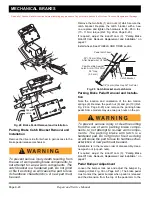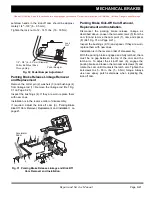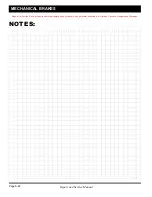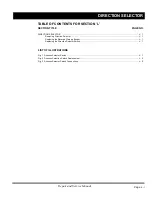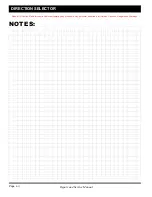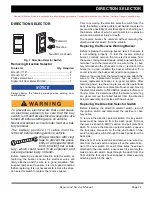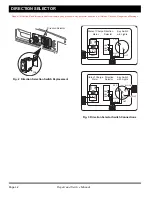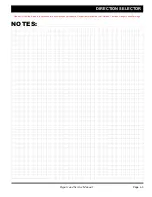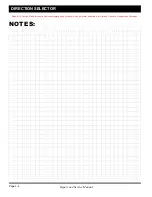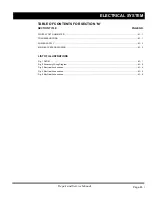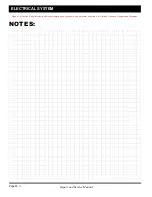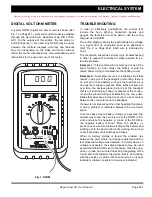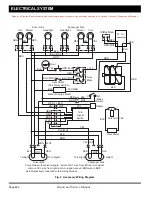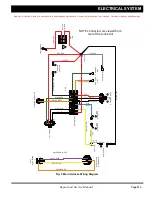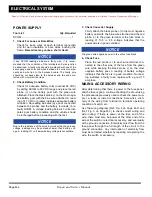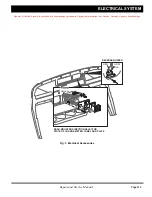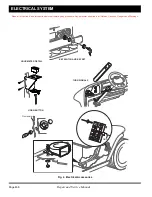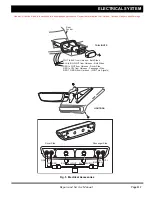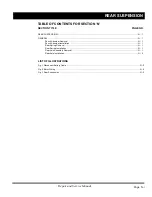
Page M-4
ELECTRICAL SYSTEM
Repair and Service Manual
Read all of Section B and this section before attempting any procedure. Pay particular attention to all Notices, Cautions, Dangers and Warnings.
POWER SUPPLY
Tool List
Qty. Required
DVOM ......................................................................... 1
1. Check For Loose or Bare Wires
Check for loose wires at each terminal connection
and for worn insulation or bare wires touching the
frame. Bare wires may cause a short circuit.
If any DVOM readings indicate a faulty wire, it is recom-
mended that the condition of the terminals and wire junction
be examined. A faulty wire should be replaced with one of the
same gauge and color and wired between the correct compo-
nents and wire tied to the harness bundle. The faulty wire
should be cut back close to the harness and the ends pro-
tected with vinyl electrical tape.
2. Check Battery Condition
Check for adequate battery volts (nominal 48 VDC)
by setting DVOM to 50 VDC range and place the red
probe (+) on the battery post with the green wire
attached. Place the black probe (-) on the most nega-
tive battery post with the blue wire attached. A read-
ing of 47 VDC or greater indicates adequate battery
condition. No reading indicates (a) a poor connection
between the probes and the battery terminals; (b) a
faulty DVOM. A voltage reading below 47 volts indi-
cates poor battery condition and the vehicle should
be recharged before proceeding with the test.
Due to the resistance of the wires involved within the harness,
voltage readings may be somewhat lower than battery volt-
age. A reading of 1 volt below battery voltage is acceptable.
3. Check Converter Supply
Firmly attach the black probe (-) to the most negative
battery post with the blue wire attached and the red
probe (+) to the green terminal at the fuse block. A
reading of 13.5 +/- 0.5 voltage indicates that the
power wire is in good condition.
The green wire supplies power to the entire fuse block.
4. Check Fuse
Place the red probe (+) to each wire terminal con-
nected to the other side of the fuse from the green
wire while keeping the black probe (-) on the most
negative battery post. A reading of battery voltage
indicates that the fuse is in good condition. No read-
ing indicates a faulty fuse; replace with a good 15
amp fuse.
MAIN & ACCESSORY WIRING
After determining that there is power to the fuse panel,
and the fuse is good, continue checking the circuit using
the procedures previously used to check the power sup-
ply, i.e. loose or rusted connections, bare wires, conti-
nuity of the wiring from terminal to terminal, operating
condition of switch, etc.
Use the wiring diagram (Ref. Fig. 2 on Page M-2) and
(Ref. Fig. 3 on Page M-3) to check correct wiring and
wire routing. If there is power at the fuse end of the
wire, there must also be power at the other end of the
wire at the switch or electrical accessory, and eventually
at the ground connection. Electricity must flow from the
fuse panel through the full length of the circuit to the
ground connection. Any interruption of electricity flow
must be corrected, whether by repairing or replacing the
wire, the switch or accessory.
NOTICE
NOTICE
NOTICE

